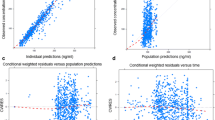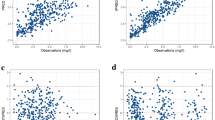Abstract
Background
Lopinavir (LPV)/ritonavir (RTV) co-formulation (LPV/RTV) is a widely used protease inhibitor (PI)-based regimen to treat HIV-infection. As with all PIs, the trough concentration (C trough) is a primary determinant of response, but the optimum exposure remains poorly defined. The primary objective was to develop an integrated LPV population pharmacokinetic model to investigate the influence of α-1-acid glycoprotein and link total and free LPV exposure to pharmacodynamic changes in HIV-1 RNA and assess viral dynamic and drug efficacy parameters.
Methods
Data from 35 treatment-naïve HIV-infected patients initiating therapy with LPV/RTV 400/100 mg orally twice daily across two studies were used for model development and simulations using ADAPT. Total LPV (LPVt) and RTV concentrations were measured by high-performance liquid chromatography with ultraviolet (UV) detection. Free LPV (LPVf) concentrations were measured using equilibrium dialysis and mass spectrometry.
Results
The LPVt typical value of clearance (\( {\text{CL}}_{{{\text{LPV}}_{\text{t}} }} /F \)) was 4.73 L/h and the distribution volume (\( V_{{{\text{LPV}}_{\text{t}} }} /F \)) was 55.7 L. The clearance (\( {\text{CL}}_{{{\text{LPV}}_{\text{f}} }} /F \)) and distribution volume (V f/F) for LPVf were 596 L/h and 6,370 L, respectively. The virion clearance rate was 0.0350 h−1. The simulated \( {\text{LPV}}_{{{\text{LPV}}_{\text{t}} }} \) C trough values at 90 % (EC90) and 95 % (EC95) of the maximum response were 316 and 726 ng/mL, respectively.
Conclusions
The pharmacokinetic–pharmacodynamic model provides a useful tool to quantitatively describe the relationship between LPV/RTV exposure and viral response. This comprehensive modelling and simulation approach could be used as a surrogate assessment of antiretroviral (ARV) activity where adequate early-phase dose-ranging studies are lacking in order to define target trough concentrations and possibly refine dosing recommendations.





Similar content being viewed by others
References
AIDSinfo. Guidelines for the use of antiretroviral agents in HIV-1-infected adults and adolescents. Department of Health and Human Services; 2013. http://aidsinfo.nih.gov/ContentFiles/AdultandAdolescentGL.pdf (Accessed 6 July 2013).
Kushner I. The phenomenon of the acute phase response. Ann N Y Acad Sci. 1982;389:39–48.
Benet LZ, Hoener BA. Changes in plasma protein binding have little clinical relevance. Clin Pharmacol Ther. 2002;71(3):115–21.
Belpaire FM, Bogaert MG. Pharmacokinetic and pharmacodynamic consequences of altered binding of drugs to alpha 1-acid glycoprotein. Prog Clin Biol Res. 1989;300:337–50.
Crommentuyn KM, Kappelhoff BS, Mulder JW, et al. Population pharmacokinetics of lopinavir in combination with ritonavir in HIV-1-infected patients. Br J Clin Pharmacol. 2005;60(4):378–89.
FDA. Prescribing information for KALETRA. Reference ID: 2909830. http://www.accessdata.fda.gov/drugsatfda_docs/label/2011/021251s039,021906s032lbl.pdf (Accessed 26 March 2013).
Sham HL, Kempf DJ, Molla A, et al. ABT-378, a highly potent inhibitor of the human immunodeficiency virus protease. Antimicrob Agents Chemother. 1998;42(12):3218–24.
Ofotokun I, Chuck SK, Binongo JN, et al. Lopinavir/ritonavir pharmacokinetic profile: impact of sex and other covariates following a change from twice-daily to once-daily therapy. J Clin Pharmacol. 2007;47(8):970–7.
Ofotokun I, Lennox JL, Eaton ME, et al. Immune activation mediated change in alpha-1-acid glycoprotein: impact on total and free lopinavir plasma exposure. J Clin Pharmacol. 2011;51(11):1539–48.
Schumitzky A. EM algorithms and two stage methods in pharmacokinetic population analysis. In: D’Argenio DZ, editor. Advanced methods of pharmacokinetic and pharmacodynamic systems analysis. Vol. 2. New York: Plenum Press; 1995. p. 60.
Walker S. An EM algorithm for nonlinear random effects models. Biometrics. 1996;52(3):934–44.
D’Argenio D, Schumitzky A, Wang X. ADAPT 5 user’s guide: pharmacokinetic/pharmacodynamic systems analysis software. Los Angeles: Biomedical Simulations Resource; 2009.
Bergstrand M, Hooker AC, Wallin JE, et al. Prediction-corrected visual predictive checks for diagnosing nonlinear mixed-effects models. AAPS J. 2011;13(2):143–51.
Lindbom L, Ribbing J, Jonsson EN. Perl-speaks-NONMEM (PsN)—a Perl module for NONMEM related programming. Comput Methods Programs Biomed. 2004;75(2):85–94.
Jonsson EN, Karlsson MO. Xpose—an S-PLUS based population pharmacokinetic/pharmacodynamic model building aid for NONMEM. Comput Methods Programs Biomed. 1999;58(1):51–64.
Zhang C, Denti P, Decloedt E, et al. Model-based approach to dose optimization of lopinavir/ritonavir when co-administered with rifampicin. Br J Clin Pharmacol. 2012;73(5):758–67.
Baker SD, Li J, ten Tije AJ, et al. Relationship of systemic exposure to unbound docetaxel and neutropenia. Clin Pharmacol Ther. 2005;77(1):43–53.
Wu H, Huang Y, Acosta EP, et al. Modeling long-term HIV dynamics and antiretroviral response: effects of drug potency, pharmacokinetics, adherence, and drug resistance. J Acquir Immune Defic Syndr. 2005;39(3):272–83.
Bonhoeffer S, May RM, Shaw GM, et al. Virus dynamics and drug therapy. Proc Natl Acad Sci USA. 1997;94(13):6971–6.
Fang J, Jadhav PR. From in vitro EC50 to in vivo dose-response for antiretrovirals using an HIV disease model. Part I: a framework. J Pharmacokinet Pharmacodyn. 2012;39(4):357–68.
Weller S, Radomski KM, Lou Y, et al. Population pharmacokinetics and pharmacodynamic modeling of abacavir (1592U89) from a dose-ranging, double-blind, randomized monotherapy trial with human immunodeficiency virus-infected subjects. Antimicrob Agents Chemother. 2000;44(8):2052–60.
Gieschke R, Fotteler B, Buss N, et al. Relationships between exposure to saquinavir monotherapy and antiviral response in HIV-positive patients. Clin Pharmacokinet. 1999;37(1):75–86.
Gulati A, Boudinot FD, Gerk PM. Binding of lopinavir to human alpha1-acid glycoprotein and serum albumin. Drug Metab Dispos. 2009;37(8):1572–5.
Funk GA, Fischer M, Joos B, et al. Quantification of in vivo replicative capacity of HIV-1 in different compartments of infected cells. J Acquir Immune Defic Syndr. 2001;26(5):397–404.
Takahashi M, Kudaka Y, Okumura N, et al. Pharmacokinetic parameters of lopinavir determined by moment analysis in Japanese HIV type 1-infected patients. AIDS Res Hum Retroviruses. 2008;24(1):114–5.
Dailly E, Reliquet V, Raffi F, et al. A population approach to study the influence of nevirapine administration on lopinavir pharmacokinetics in HIV-1 infected patients. Eur J Clin Pharmacol. 2005;61(2):153–6.
Bouillon-Pichault M, Jullien V, Azria E, et al. Population analysis of the pregnancy-related modifications in lopinavir pharmacokinetics and their possible consequences for dose adjustment. J Antimicrob Chemother. 2009;63(6):1223–32.
Ng J, Chiu YL, Awni W, et al. Pharmacokinetics and safety of the lopinavir/ritonavir tablet 500/125 mg twice daily coadministered with efavirenz in healthy adult participants. J Clin Pharmacol. 2012;52(8):1248–54.
Overton ET, Tschampa JM, Klebert M, et al. The effect of acid reduction with a proton pump inhibitor on the pharmacokinetics of lopinavir or ritonavir in HIV-infected patients on lopinavir/ritonavir-based therapy. J Clin Pharmacol. 2010;50(9):1050–5.
Boffito M, Hoggard PG, Lindup WE, et al. Lopinavir protein binding in vivo through the 12-hour dosing interval. Ther Drug Monitor. 2004;26(1):35–9.
Bree F, Houin G, Barre J, et al. Pharmacokinetics of intravenously administered 125I-labelled human alpha 1-acid glycoprotein. Clin Pharmacokinet. 1986;11(4):336–42.
Acosta EP, Limoli KL, Trinh L, et al. Novel method to assess antiretroviral target trough concentrations using in vitro susceptibility data. Antimicrob Agents Chemother. 2012;56(11):5938–45.
Schipani A, Dickinson L, Boffito M, et al. Simultaneous population pharmacokinetic modelling of atazanavir and ritonavir in HIV-infected adults and assessment of different dose reduction strategies. J Acquir Immune Defic Syndr. 2013;62(1):60–6.
Lopez Aspiroz E, Santos Buelga D, Cabrera Figueroa S, et al. Population pharmacokinetics of lopinavir/ritonavir (Kaletra) in HIV-infected patients. Ther Drug Monitor. 2011;33(5):573–82.
Ho DD, Neumann AU, Perelson AS, et al. Rapid turnover of plasma virions and CD4 lymphocytes in HIV-1 infection. Nature. 1995;373(6510):123–6.
Mohri H, Bonhoeffer S, Monard S, et al. Rapid turnover of T lymphocytes in SIV-infected rhesus macaques. Science. 1998;279(5354):1223–7.
Wei X, Ghosh SK, Taylor ME, et al. Viral dynamics in human immunodeficiency virus type 1 infection. Nature. 1995;373(6510):117–22.
Perelson AS, Neumann AU, Markowitz M, et al. HIV-1 dynamics in vivo: virion clearance rate, infected cell life-span, and viral generation time. Science. 1996;271(5255):1582–6.
Dimitrov DS, Willey RL, Sato H, et al. Quantitation of human immunodeficiency virus type 1 infection kinetics. J Virol. 1993;67(4):2182–90.
Stafford MA, Corey L, Cao Y, et al. Modeling plasma virus concentration during primary HIV infection. J Theor Biol. 2000;203(3):285–301.
Acknowledgments
This work was supported by National Institutes of Health grants 1K23 A1073119 (IO), 5K12 RR017643 (IO), 1U01AI103408-01 (IO), P41-EB001978 (DZD), KL2TR000455 (ANS), UL1TR000454 (ANS), Emory University CFAR (NIH P30 A1050409), and the Atlanta Clinical and Translational Science Institute (NIH MO1 RR00039). We would like to acknowledge the individuals that participated in these studies. Without their dedication this work could not have been accomplished.
Conflict of Interest
None of the authors has any conflicts of interest that are relevant to the content of this article.
Author information
Authors and Affiliations
Corresponding author
Electronic Supplementary Material
Below is the link to the electronic supplementary material.
Rights and permissions
About this article
Cite this article
Wang, K., D’Argenio, D.Z., Acosta, E.P. et al. Integrated Population Pharmacokinetic/Viral Dynamic Modelling of Lopinavir/Ritonavir in HIV-1 Treatment-Naïve Patients. Clin Pharmacokinet 53, 361–371 (2014). https://doi.org/10.1007/s40262-013-0122-1
Published:
Issue Date:
DOI: https://doi.org/10.1007/s40262-013-0122-1




